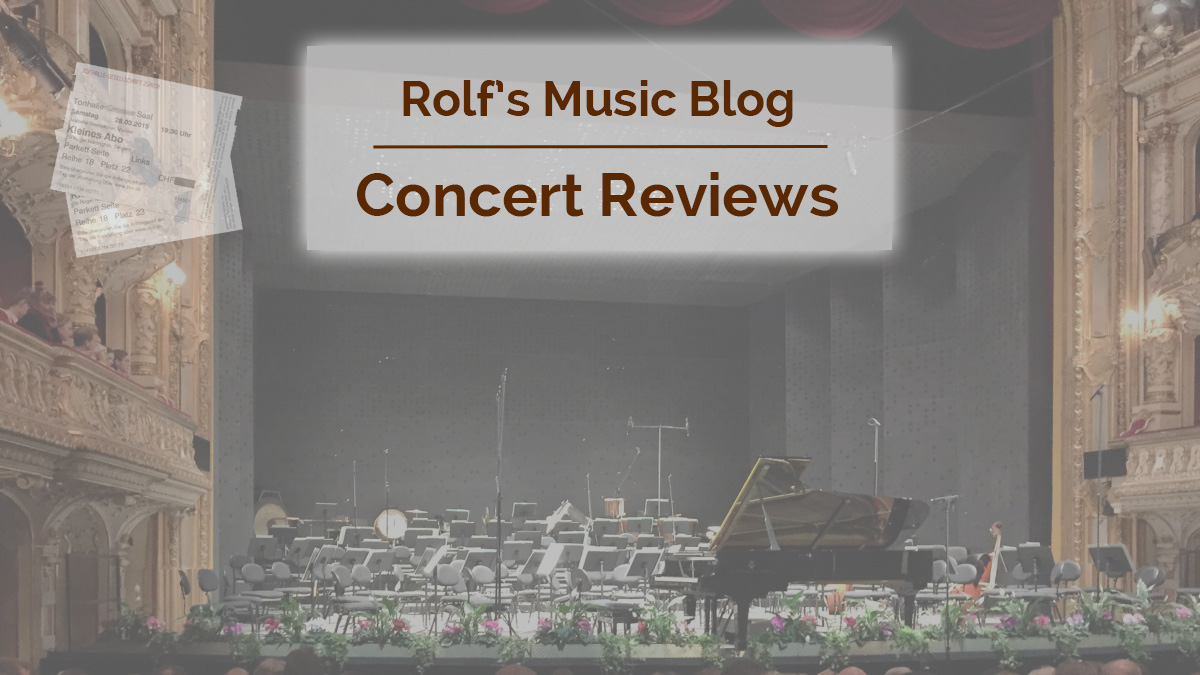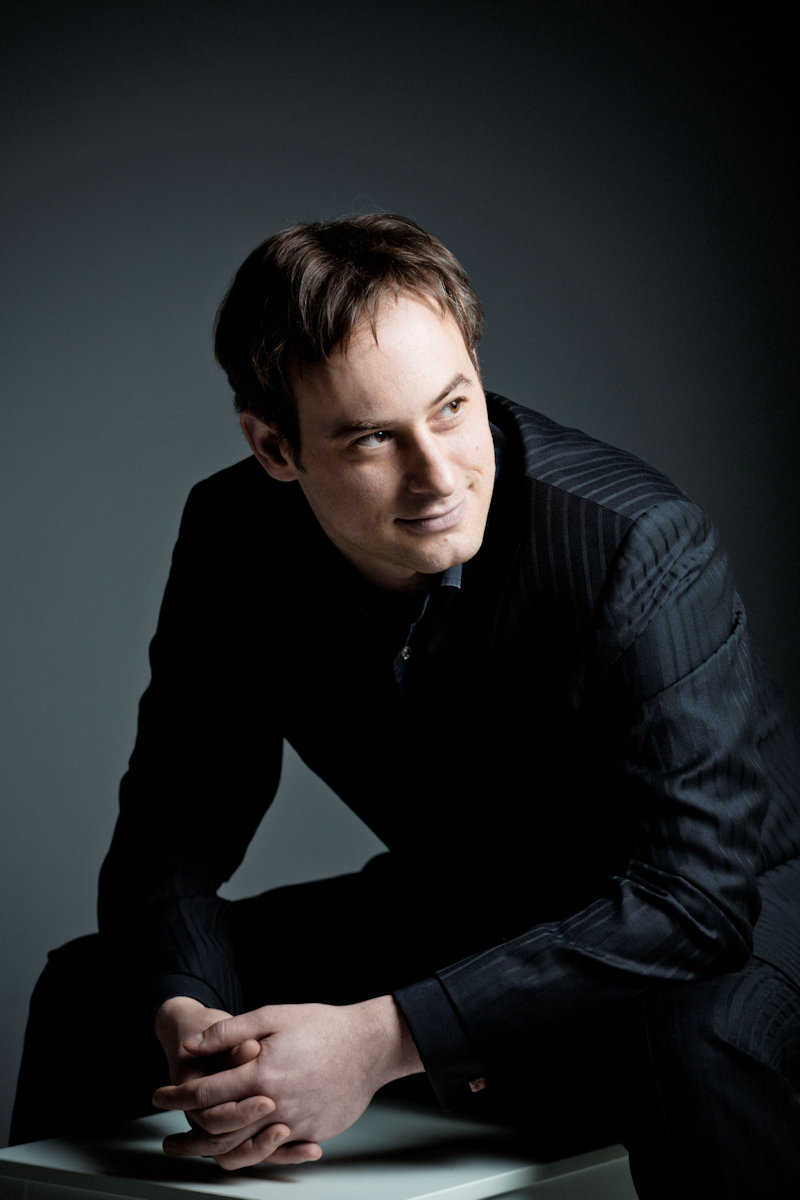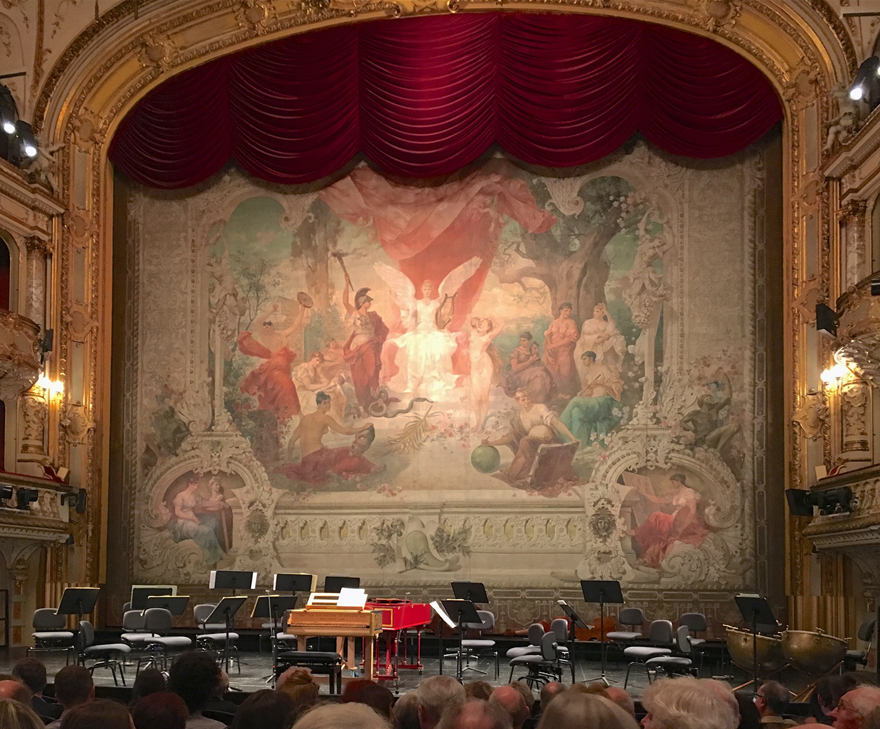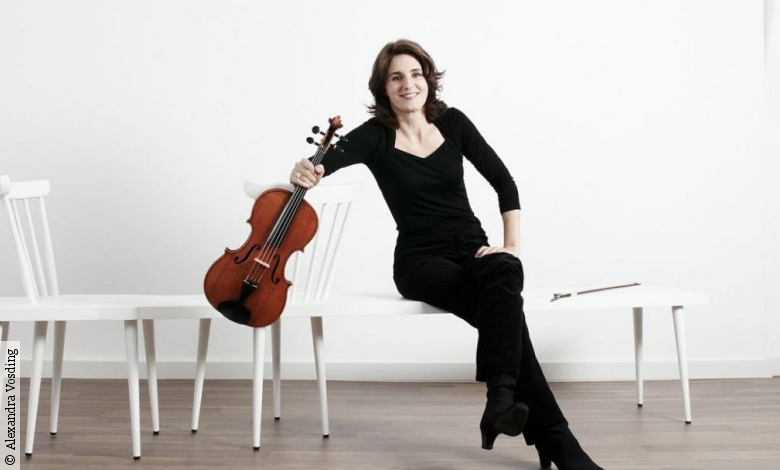Hanna Weinmeister, Jonathan Cohen / La Scintilla
Works by Johann Sebastian Bach (1685 – 1750)
Zurich Opera, 2017-07-03

2017-07-12 — Original posting
Bach in der Oper? Hanna Weinmeister und Jonathan Cohen / La Scintilla in Zürich— Zusammenfassung
Der britische Dirigent, Cellist und Cembalist Jonathan Cohen leitete das Orchestra La Scintilla Zürich, die “historische Fraktion” des Opernhaus-Orchesters. Er griff zuweilen in die Tasten. Den Hauptteil des Continuospiels leistete ihm gegenüber Naoki Kitaya an einem zweiten Cembalo, und in der Leitung wurde er in den Suiten von der aufmerksamen Konzertmeisterin Hanna Weinmeister unterstützt.
Das Programm bestand ausschließlich aus Werken von Bach. Als Rahmen die Orchestersuiten Nr.3 (BWV 1068) und Nr.4 (BWV 1069). Jonathan Cohen forderte die Barockinstrumente bis ans Limit. Faszinierend fand ich die Klangrede, diese lebendige, sprechende, kleinräumige Agogik. Und natürlich den Klang der Instrumente! Wohltuend warm, weich, nie schneidend, die Oboen ohne Schärfe und mit sanfter Ansprache.
Hanna Weinmeister, Solo Violin
Im Violinkonzert in E-dur spielte Hanna Weinmeister den Solopart. Sie fügte sich nahtlos in den Ensembleklang ein. Sie blieb zurückhaltend im Ton, weit entfernt von Stargehabe und Sich-ins-Zentrum-Stellen. Die Aufmerksamkeit richtete sich auf die lebendige Artikulation und Agogik der Solistin. Sie untermalte dies mit entsprechender Körpersprache. In der Reprise fügte die Solistin diskret Ornamente ein. Kein klassisches, eher ein Kammerkonzert, dessen intimer Charakter durch den pp-Schluss unterstrichen wurde. Ein diskretes Vibrato hörte man allenfalls als Verzierung im langsamen Satz. In dessen Mittelteil steigerte sich die Intimität der Gefühlswärme noch.
Im 6. Brandenburgischen Konzert kam die Spielfreude noch vermehrt zum Ausdruck: im ersten Satz erzeugten Gamben und Continuo fast Rossini-Motorik, elektrisierende Spannung. Die zwei Bratschistinnen schienen im Kanon um die Führung zu wetteifern. Der Mittelsatz war ein intimes Zwiegespräch zwischen den beiden Violen. Besonders gefielen mir die langsam anlaufenden Triller. Im Allegro schließlich erfreuten das entspannte Musizieren und die nahtlose Ablösung der Motive in den Violen. Cohen ließ den Violen Freiheit in der Agogik, nahm erst bei der Wiederkehr des Ritornells das Tempo wieder auf.
Table of Contents
Introduction
The Orchestra La Scintilla Zurich
The origins of the Orchestra La Scintilla Zurich date back toto the Monteverdi cycle at the Zurich Opera in the late 1970s. For that cycle, Nikolaus Harnoncourt (1929 – 2016) formed a baroque orchestra / ensemble. In parts, it consisted of musicians of the local orchestra (then still part of the Tonhalle Orchestra). In addition there were local baroque music specialists, and select musicians from Vienna, such as Harnoncourt’s wife Alice Harnoncourt. The ensemble also supported the subsequent performances of Mozart operas under the stage direction of Jean-Pierre Ponnelle (1932 – 1988). In 1996, finally, “La Scintilla” emerged as an independent ensemble. It specializes in historically informed performances of music from the baroque up to the classical period.
The ensemble performed with notable conductors such as Nikolaus Harnoncourt, William Christie (*1944), Mark Minkowski (*1962), Reinhard Goebel (*1952) and Giuliano Carmignola (*1951).
Jonathan Cohen, Conductor
In this concert, the British conductor, cellist, and keyboard artist Jonathan Cohen (*1977, Manchester) was leading “La Scintilla” as guest conductor. Jonathan is Artistic Director of “Arcangelo“. He is also Associate Conductor of William Christie’s “Les Arts Florissants“. In addition, he is Artistic Director of the Tetbury Festival, and Artistic Partner of the Saint Paul Chamber Orchestra. Jonathan Cohen also was a founding member of The London Haydn Quartet. For more information see also Wikipedia.
The Soloist
A key component in this concert was the Austrian violinist Hanna Weinmeister. She is the first solo violinist of the orchestra of Zurich Opera, Philharmonia Zurich (since 1998). At the same time, she is concertmaster of the “Orchestra La Scintilla Zurich”. She plays the Stradivarius violin “Bennett” from 1692.
The Opera House as Concert Venue
So far, from past experience, I have been skeptical about instrumental concert in the Opera House. Quite in general, it appeared to me that the acoustics of an opera or theater are hardly suited for concerts that don’t focus on singing or on the spoken word. Such venues are built for optimum acoustic clarity. Therefore, they offer little or no reverberation. Some sites try compensating this deficiency by using microphones and electronics to produce artificial reverberation. A set of distributed loudspeakers then projects this into the auditorium. With very limited, if not questionable success, to the best of my knowledge.
On top of that, using a stage as orchestra podium bears the danger that a part of the sound disappears into the space surrounding the stage. This is a particular issue for musicians sitting in the rear of the stage. A casing around the stage area often proves to be of limited efficiency.
Worries about Acoustics?
I had never heard the baroque orchestra since the days of Nikolaus Harnoncourt and his Mozart cycle. For this concert, my curiosity to hear “La Scintilla” again after so many years were bigger than my worries about acoustic limitations. And I was happy about that decision!
The Setup in this Concert
A first, very positive surprise (to be expected, though): in this concert, the stage was closed off by means of the fire protection curtain. A baroque painting covered the curtain. It depicted an antique scenery, surrounded by a Trompe-l’œil architectural frame. The orchestra pit had been covered by an add-on podium. Here, La Scintilla was playing in the center of the semi-circular auditorium. This already swept away most of my concerns about the acoustics.
More important, however, was the orchestra and its playing! Jonathan Cohen was conducting from the harpsichord, with his back towards the audience. For Bach’s orchestral suites, there was a second harpsichord, facing the audience. This was the “proper” continuo instrument, on which Naoki Kitaya played the (ciphered) basso continuo. Particularly in the suites, Jonathan Cohen touched the keyboard only occasionally, as reinforcement of the bass. Of course, in the suites, Cohen also received support by the attentive concert master, Hanna Weinmeister.
Up to the intermission, Jonathan Cohen played a single-manual harpsichord by Jan Kalsbeek, Zutphen, NL (8′ + 8′, 1997). Naoki Kitaya played a single-manual harpsichord by Henk Klop, Garderen, NL (8′ + 8′). After the intermission, Cohen switched to the Klop instrument. In the last piece, Naoki Kitaya used the Kalsbeek instrument for the continuo.
Historically Informed Playing in Zurich
Zurich may not be the world’s foremost center in historically informed performances (HIP). Yet, HIP performances receive plenty of attention with our audiences:
- For baroque and early classical repertoire, even the Tonhalle Orchestra (a child of the late-romantic period!) is inviting specialists such as Ton Koopman (*1944) or Giovanni Antonini (*1965). With the help of such lead figures, they have learned playing with lighter articulation, more direct & expressive dynamics, etc.
- Even more so, the Zurich Chamber Orchestra (Zürcher Kammerorchester, ZKO) is operating in such territory. Especially under the guidance of his recent Chief Conductor, Sir Roger Norrington (*1934). Here, one can—depending on the repertoire, of course—often observe the use of baroque and classic / period bows, as well as period (or replica) wind instruments. However, the ZKO continues to support a broad repertoire, up to contemporary music. The ZKO will therefore often use modern instruments, as they see fit.
The situation is very much different with the “Orchestra La Scintilla“, already given its origins (see above). Right from the beginning, it was designed to be an ensemble specifically and exclusively for the baroque and early classical periods. It’s a small, but exquisite group of musicians. It not only uses baroque wind instruments and period bows, but also gut strings. And the result absolutely justifies this effort!
Orchestral Suite No.3 in D major, BWV 1068
Bach wrote four orchestral suites, No.1 in C major BWV 1066, No.2 in B minor BWV 1067 (with flute), No.3 in D major BWV 1068, and No.4 in D major BWV 1069.. Among these, No.3 and No.4 are the most festive ones. No.3 asks for 3 trumpets, 2 oboes, timpani, strings and basso continuo. No.4 even asks for a third oboe and a bassoon. In all suites, the first movement is an overture, after which a series of baroque dance movements follows. In the case of the Suite No.3, these movements are
- Ouverture, 4/4
- Air, 4/4
- Gavotte I/II, 2/2
- Bourrée, 2/2
- Gigue, 6/8
The Performance
From the very first tone, everything seemed to fit in this performance. The sound of the baroque instruments, the tempo, the light articulation, the vivid dynamics. With that music, I instantly stopped worrying about the acoustics. Even without noticeable reverberation, I felt that the room supported all string and wind instruments equally well.
In my opinion, only the harpsichords were slightly underrepresented in the sound mix. However, they don’t have a solo function here. They merely (or mostly) serve as a means of coordination, of harmonic support. It’s mostly the musicians in the ensemble who need to hear the continuo instrument. For the listener, they just add extra rhythmic clarity. Yet, whenever Naoki Kitaya occasionally added little fiorituras as filler in transitions, one could certainly hear—and enjoy!—these very well.
I. Ouverture
An entire evening with “just Bach” might initially sound monotonous, if not even boring. That evening could not have been any farther from this! Pretty much throughout, Jonathan Cohen chose a fluent tempo. Even the introduction was never static, but moving along fluently.
Sometimes the pace even was near the upper limit. This was at least close to making the coordination suffer. For example, in the fast (vite) part of the Ouverture, the trumpets occasionally were a tad ahead of the others. Also the baroque oboes sometimes seemed to be challenged. But the music had momentum, drive, even swing.
I really liked the warm, mellow tone of the string instruments. It was never incisive, thanks to the gut strings. Also, the baroque oboes were mixing with the gut strings very well, with mellow articulation and tone. They lacked the often penetrating sharpness of the modern instruments. It seemed to me that all potential balance issues of such mixed ensembles were essentially non-existent here.
Hanna Weinmeister
In the center of the fast segment of the Ouverture, Hanna Weinmeister performed the first violin part as solo. Her playing was natural, she never appeared to try standing out—excellent! Cohen observed the repeats for both parts of this movement.
Throughout the evening, the articulation was light, every note was discharged, also in slow movements. Of course, the discharging is almost a given with the short baroque bow. The danger of “Nachdrücken” is virtually eliminated, that of belly notes minimized. With the articulation, I liked the “Klangrede” (one of Harnoncourt’s favorite terms!). The vivid, “speaking”, small-scale agogics were so far away from the “sewing machine articulation” that people liked some 60 years ago!
II. Air
The Air is all-too familiar. But also here, it all sounded fresh, the melody was legato, but never too dense, “thick”, let alone overblown. It certainly helped that the continuo performed the bass line as stepping, soft staccato (rather a portato). The differentiation in the dynamics definitely added to the listening pleasure, as did Naoki Kitaya’s subtle ornamentation on the harpsichord. It wasn’t nearly the earworm that I was afraid to hear!
III. Gavotte I/II
In the Gavottes, the sound of the natural trumpets dominates. The tempo was fluent, but the playing retained excellent control and articulation. I personally would put a little question mark behind the decision to perform all appoggiaturas as acciaccaturas. However, that was a negligible irritation, if any at all.
IV. Bourrée
The dominant role of the three trumpets continues through the remaining movements.
V. Gigue
Cohen took the final, brilliant Gigue movement (6/8 time) attacca, i.e., it followed the Bourrée without interruption, even ignoring the fermata in the score. The tempo here was very fluent. I would not say that the trumpets and oboes were struggling, but the tempo was a challenge, I think.
Concerto for Violin and Orchestra in E major, BWV 1042
For the Violin Concerto in E major, BWV 1042, the wind instruments and the timpani player left the podium, leaving only 4 + 4 + 2 + 2 + 1 string instruments in the tutti. Hanna Weinmeister now was the soloist, standing next to Jonathan Cohen.
The concerto in E major most likely originates from Bach’s time in Weimar (1708 – 1717). It features three movements:
- Allegro, 2/2
- Adagio, 3/4
- Allegro assai, 3/8
The Performance
I. Allegro
It was fascinating to experience to witness how the sound of Hanna Weinmeister’s violin seamlessly merged with the orchestra, re-emerged from the ensemble for the solos. It was such joy to see how inconspicuously she performed her part. Hanna Weinmeister retained the necessary presence, but never tried pushing the tone or her role as soloist. There was no stardom, no virtuoso attitude. Needless to say that her 1692 (early) Stradivarius had no problem in making itself heard sufficiently well. Even with the soft gut string sound, the instrument projected well enough, at all times.
In the “recapitulation section”, Hanna Weinmeister discreetly (and very aptly) added some extra ornaments. Also the short cadenza retained “human dimensions”, not just artistically, but also in sound. This clearly was not a classical (virtuosic) concerto, but rather a kind of chamber concerto. The pp ending underlined the intimate character of this movement.
II. Adagio
Needless to say that Hanna Weinmeister essentially played without vibrato. Scarce, discreet vibrating appeared in the slow movement, just as ornament, to highlight key points in a melody. Almost unnoticeably, the soloist was “sneaking in” with her part. In the central part of the Adagio, the intimacy, the warmth was almost extreme. Yet, of course, devoid of all exaggeration.
III. Allegro assai
The final movement was almost dance-like, swinging, fluent. Hanna Weinmeister read the slurs in Bach’s notation as phrasing bows / instructions, not as legato instruction. I can’t object to this, especially given the shortness of the baroque bow.
Besides the sound, my attention was on the soloist’s vivid articulation and agogics. This was associated with lively body language and gestures. Hanna Weinmeister did not try making a “big concerto” out of this. It’s excellent music, of course, but not a virtuoso’s showpiece! To me, this was an outstandingly harmonious performance of this concerto. It was more compelling than any other performance of Bach’s violin concertos that I have witnessed recently. Or ever, even, no matter how well their solo parts were played. Recent performances include the Violin Concerto in A minor BWV 1041 (ZKO, 2016-09-27) and the Violin Concerto in E major BWV 1042 (Lyra Foundation, 2017-05-09). Plus, the Violin Concerto in D minor BWV 1052R (ZKO, 2016-03-15).
Brandenburg Concerto No.6 in B♭ major, BWV 1051
1721, Bach presented the “Brandenburg” concerti to Christian Ludwig, Margrave of Brandenburg-Schwedt. The time of the actual writing is not known. Among the six concerti, the Concerto No.6 in B♭ major, BWV 1051, is my favorite. The exact title is “Concerto 6to à due Viole da Braccio, due Viole da Gamba, Violoncello, Violone e Cembalo“. One could describe this as chamber concerto for two violas. However, also the viole da gamba have a prominent role in the three movements:
- (tempo ordinario), 2/2
- Adagio ma non tanto, 3/2
- Allegro, 12/8
The Performance
Here, the ensemble was smaller again. The concerto only requires two violas, two viole da gamba, cello, and continuo (violone, harpsichord). Jonathan Cohen was sitting at the one harpsichord. However, he only touched the keyboard when the score asked for violone / continuo. Otherwise, he was mostly observing, letting the ensemble play by itself. The two violists were standing on the left.
I. (tempo ordinario)
In this smaller formation, the joy of playing was even more evident than in the other works. Bach did not specify a tempo here, so people assume “tempo ordinario“, i.e., a pace around Andante up to Allegro. Here, the viole da gamba and the basso continuo developed almost Rossinian motoric drive, electrifying tension. The two violas seemed to compete against each other for the lead position in their canon-like duet.
II. Adagio ma non tanto
The Adagio ma non tanto felt like an intimate, intense dialog between the two violas. I particularly liked the trills, which started slowly, then accelerated gradually. Even when the music seems to go through hesitations towards the end of the movement, the musical flow never stopped.
III. Allegro
The last movement featured relaxed, joyful playing. I liked how the semiquaver motifs seamlessly moved between the two violas. Jonathan Cohen gave the two violas all the freedom they wanted in tempo and agogics. Only when the ritornello returned, he resumed the original pace. Was it perfect playing? No! Definitely to me, the joy of playing, the atmosphere were far more important. And it was pure joy to listen to this!
Orchestral Suite No.4 in D major, BWV 1069
As mentioned above, the fourth orchestral suite is even more festive and brilliant than No.3. It requires 3 trumpets, timpani, 3 oboes, bassoon. Plus, of course, the strings: 2 violin voices, viola, and the continuo (cello, violone, harpsichord). Needless to say: all wind instruments were period models, i.e., valve-less / natural trumpets, baroque oboes, baroque bassoon. The Orchestral Suite No.4 in D major, BWV 1069 features the following 5 movements:
- Ouverture, 4/4 — 9/8 — 4/4
- Bourrée I/II, 4/4
- Gavotte, 4/4
- Menuet I/II, 3/4
- Réjouissance, 3/4
The Performance
Here, we again saw Hanna Weinmeister at the first violin desk, taking a very active lead role.
I. Ouverture
As already in the opening Suite, the Ouverture started at a fluent tempo. Note that unlike in typical French style overtures, the score notation was left as is. No extra double punctuation was required, as Bach already applied that in the score, where appropriate. Already the festive beginning featured light articulation, avoiding unnecessary pomp. In the “fast(er)” 9/8 section, the articulation was even lighter, “discharging” every motif. The second part was not repeated.
II. Bourrée I/II
Cohen took the tempo as fast as manageable (just about) by the baroque oboes and the baroque bassoon (also in several other movements). These instruments feature a delightful, mellow sound. However, their intonation purity and articulation isn’t nearly as clear and pure as with modern instruments. However, perfection clearly was not the goal here.
III. Gavotte
This movement is easier on the oboes, the fast note values are more with bassoon and the strings.
IV. Menuet I/II
Here, I liked the inégale articulation of the quaver pairs in the first Menuet—very nice! It gave the piece a particular, swaying flow. The second Menuet was partly performed by soloists, which gave this a much more intimate touch.- I really liked it!
V. Réjouissance
The tempo in this movement was definitely at the upper limit, particularly for the trumpets. The articulation was still clear, clean. However, the coordination started to suffer. The audience noted this with a smile, but still applauded strongly. When Jonathan Cohen offered the Réjouissance as an encore, though, it definitely sounded and felt like a joyful last dance. However, this only confirmed that it is the experience, the atmosphere, which counts in such a live concert. Perfection is for the CD!
Addendum
For the same concert, I have also written a (shorter) review in German for Bachtrack.com. This posting is not a translation of the Bachtrack review, the rights of which remain with Bachtrack.com. I created the German review using a subset of the notes taken during this concert. I wanted to enable my non-German speaking readers to read about my concert experience as well. Therefore, I have taken my original notes as a loose basis for this separate posting. I’m including additional material that is not present in the Bachtrack review.






